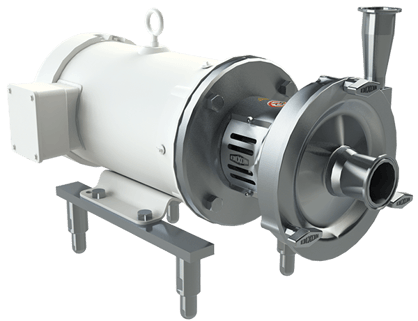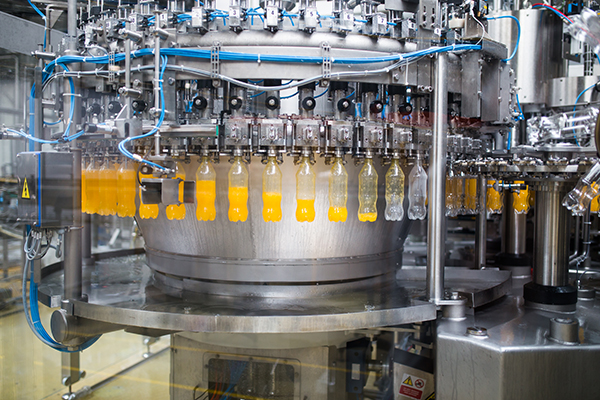
 Photo courtesy of iStock/DuxX
Photo courtesy of iStock/DuxX
Robotic factory line for processing and bottling of soda and orange juice.
Priming the Pump
There's something oddly satisfying about the sound a soda makes when it's first opened. The hissing sound combined with the subsequent fizzing is distinctive, and the sweet flavor of the first sip is unlike anything else. In between the sounds and enjoying the deliciousness, have you ever wondered how the soda ends up in the bottle or can? Moving fluid through industrial systems is a complex but important aspect of food, beverage, and pharmaceutical processing. Sanitary pumps play a key role in the fluid transfer process.
There are two types of sanitary pumps: centrifugal and positive displacement. Both types of pumps efficiently move fluid, but they differ in how the pumps operate and the products best suited for each.

Centrifugal Pumps
Centrifugal pumps use rotational energy to move fluid. Fluid enters the pump inlet and the rotating impeller moves the fluid. The centrifugal force created by the motor and impeller sends the fluid out from the impeller eye, increasing the fluid's velocity as it is directed toward the pump outlet.
There is no suction lift with centrifugal pumps, meaning the pump must be primed, or the product must be supplied to the pump for it to work. This can be achieved by positioning the pump under the tank to allow gravity to feed fluid into the pump.
Centrifugal pumps are best suited for low-pressure, high-capacity, low-viscosity applications. The efficiency of centrifugal pumps is determined by the duty point on the pump performance curve. Understanding the system's parameters, such as system head, desired flow, and product characteristics, will help to size the correct centrifugal pump and improve efficiency. This is because the flow rate of a centrifugal pump is directly related to friction loss. There is greater resistance with high-viscosity fluids, so a larger diameter impeller or increased speed is needed to maintain flow. Thus, centrifugal pumps are most efficient with low-viscosity products where there is little to no variation in pressure or viscosity. Centrifugal pumps can handle low-viscosity products up to 500 centipoises.
Temperature is another factor to consider when selecting a sanitary pump. Centrifugal pumps can handle products from 32°F (0°C) to 212°F (100°C). A hot oil shaft can be used for temperatures up to 275°F (135°C).
Centrifugal pumps are not ideal for shear-sensitive products. Shear-sensitive liquids change viscosity under pressure. For example, water is not shear sensitive, but if you add soap it will become frothy and bubbly when agitated. Centrifugal pumps are better suited for liquids with consistent viscosity.
Little to no solids should be present in a fluid being moved by a centrifugal pump. Small seeds or particulates that do not need to remain whole are fine to go through a centrifugal pump. However, if you try to pump vegetable soup through a centrifugal pump, the result will be vegetable mush.
Centrifugal pumps are used in a wide variety of applications for a copious amount of products. Some examples include but are not limited to, water, wine, beer, soft drinks, milk, and cleaning solutions.
Positive Displacement Pumps
Positive displacement pumps also move fluid but in a different way than centrifugal pumps. There are two sides to a positive displacement pump, the suction side, and the discharge side. There is an expanding cavity on the suction side and a decreasing cavity on the discharge side. Liquid flows into the pump as the cavity expands. Then, the liquid discharges as the cavity decreases. Positive displacement pumps produce the same flow at a given speed at viscosities over 500 cP despite the discharge pressure.
Unlike centrifugal pumps, some positive displacement pumps are capable of some suction lift. Some positive displacement pumps can pull a product a short distance to prime the pump and keep the product moving.
Some positive displacement pumps can handle all viscosities from 0 to 1,000,000 cP. This range includes water all the way up to dough. However, positive displacement pumps are more efficient with high-viscosity products. This is because the high-viscosity liquid fills the internal clearances in the pump, producing a great volumetric efficiency.
Products with a wide range of temperatures can be used with a positive displacement pump. Positive displacement pumps can handle anything from frozen solid products up to 482°F (250°C).
Positive displacement pumps are also better suited for variations in pressure and viscosity. The pump can run at a slower speed to allow for variations, which also benefits shear-sensitive products. Shear-sensitive products, such as ketchup and shampoo, need to be handled gently to preserve product integrity. The slower speed and different rotors in a positive displacement pump make this possible.
The texture of a product is not a concern when using a positive displacement pump since it can move both liquids and solids. If the product fits through the pocket, it will pass through the pump.
Positive displacement pumps are utilized in a multitude of applications. Products such as chocolate, batter, frosting, ice cream, syrup, heavy whipping cream, and baby food can all be transferred with a positive displacement pump.
There is some overlap among products, such as beer and wine, that can be moved with either a centrifugal pump or a positive displacement pump. Contact a Dixon specialist for recommendations for your specific application.
Dixon's Sanitary Pumps
Dixon is delighted to offer a variety of centrifugal and positive displacement pumps for the food, beverage, and pharmaceutical industries. The pumps can be fitted with a variety of features and options to ensure the best performance will be achieved for your specific application.
Centrifugal Pumps
BC/BP-Series
Features:
- Nitrile rubber, EPDM, and FKM elastomer options
- 3A-certified stainless steel components and sanitary polish finish
- Hydrostatically tested pump

ExD-Series
Dixon's ExD-Series is an efficient by-design centrifugal pump. The efficiency comes from how well the product is moved from the inlet to the outlet of the pump.
Features:
- Casing, front cover, and impeller machined from heavy-duty forgings and precision castings
- Modular adapter and U.S. Patent Pending shaft design gives increased flexibility and reduces the purchase cost of parts when changing motor frames
- Efficient impeller and casing design with tight internal clearances and smooth geometric transitions enable gentle product handling
- Unique stub shaft leak chamber allows for immediate external identification of soft seal wear
- Unique adapter slots make pump discharge easily adjustable from 90° to 180° without any disassembly of the casing or front cover
- Compact and maintenance-friendly adapter guard
- External casing flats for easy casing drain addition
- The pump is 3A certified
 MB100-Series
MB100-Series
The MB100-Series is a microbrew-specific centrifugal pump. It can also be used in small transfer applications.
Features:
- Standard Clamp – Uses a standard 4" tube clamp for easy removal and adjustment of the casing. Eliminates post and tab construction
- Seal Design – Robust single mechanical seal design with silicon carbide stationary seal-face and carbon rotary seal-face
- Seal Performance – Efficient seal path promotes seal cooling and provides fewer restrictions to adequately clean the seal
- Impeller and Shaft Design – Sealed impeller provides optimal hygienic performance while the split shaft compression collar improves shaft concentricity, reduces vibration, and improves seal life
- Drop-in replacement for other C-100 series pumps
- Wet end mounts to a standard 56C frame motor
 JRZL-Series Rotary Lobe Pump
JRZL-Series Rotary Lobe Pump
Dixon's JRZL-Series Rotary Lobe Pump is a positive displacement pump that handles any sort of viscous or solid transfer applications.
Features:
- Small compact lightweight design equals less pump and more performance. Gently handle low to high-viscosity fluids
- Pumps can be mounted with top/bottom shaft drive, vertical/horizontal inlet/outlet
- Stainless Steel Gear Box with single oil reservoir made from precision casting offers paint-free and rust-free long-lasting durability
- Using helical timing gears, the rotors are driven at less vibration to extend pump efficiency and seal lifetime, even under high speed and high discharge pressure
- Front-loading seals provide faster maintenance, easier cleaning, and less downtime. All seal options are designed for quick and simple retrofit
- Stainless steel shims located between the gearbox and casing make it easy to adjust rotor clearance without having to completely disassemble the gearbox
- All product contact areas are standard 316L stainless steel
- JRZL-Series pumps are certified EHEDG and 3A

JRZW-Series Rotary Lobe Wine Pump
The JRZW-Series positive displacement pump is designed for wineries to use in the production, transfer, and bottling process.
Features:
- Single mechanical seal (standard) TC vs TC
- Double mechanical seal
- Triple lip-seal with ceramic-coated sleeve
- EPDM rotors for passing must, the unfermented juice from crushed grapes

Pump Carts
Dixon offers pump carts as an added option to all of our sanitary pumps. There are two standard model sizes and others are available upon request. Carts can be ordered with many options and customized to your specifications.
Closing
The food, beverage, and pharmaceutical industries all rely on sanitary pumps to move products from point A to point B for processing and bottling/packaging. The pumps play a crucial role in getting the soda mentioned earlier in a bottle or can. Using the correct type of pump for a specific application is imperative for efficiency. Understanding the difference between centrifugal and positive displacement pumps can save you time, and money, and create a successful operation.
Ready to pump up your knowledge and your operation? Visit our website to learn more about Dixon's sanitary pumps.




